The Ongoing Challenge of Modern Sword Design and Sword Making
By John Clements
ARMA Director
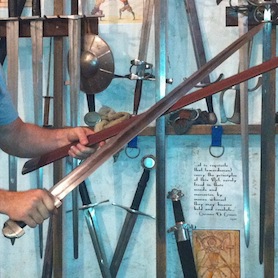 I'm
neither a bladesmith nor sword-maker in any way whatsoever. I'm in awe
of those who can take metal ore and through fire and sweat turn it into
a fine example of my favorite of historical weapons. Students of the craft
such as myself would be stuck using sticks and props if it wasn't for
the efforts of sword fabricators and bladesmiths. I'm
neither a bladesmith nor sword-maker in any way whatsoever. I'm in awe
of those who can take metal ore and through fire and sweat turn it into
a fine example of my favorite of historical weapons. Students of the craft
such as myself would be stuck using sticks and props if it wasn't for
the efforts of sword fabricators and bladesmiths.
Given what I do, though, I'm asked quite regularly to comment about modern
sword design and sword-making. I refrain from making endorsements about
reproductions and prefer to only make recommendations in person to my
students and guild members about pieces of which I have personal experience.
I really can't address the quality or work of commercial swordsmiths
because their personal handmade pieces are simply outside the affordability
of 99% of students and enthusiasts. Because of this, their work, in my
opinion, simply never gets properly tested in the manner it should--that
is, by skilled athletic practitioners who know how the originals should
perform and function. On top of this, I'm not qualified to address issues
of metallurgy or tempering, but only characteristics of performance and
handling in regard to shape and overall dimensions. My foremost concern
is always how they relate to the proper dealing and warding of blows.
I like to think the same was true for how historical swordsmen considered
these objects.
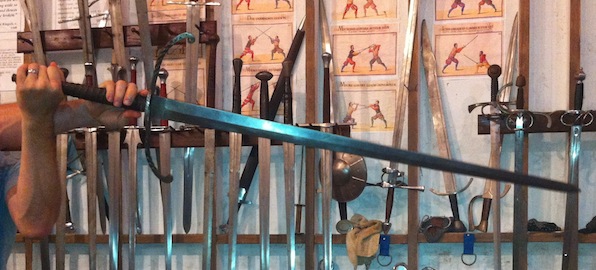
That being said, there are a number of modern master swordsmiths who
I greatly admire for their knowledge, craftsmanship, integrity, and dedication
to their art. Yet, since I don't own any of their hand-made pieces (nor
have I been able to evaluate them in the manner I want), I can't say how
accurate any particular sword of theirs truly is.
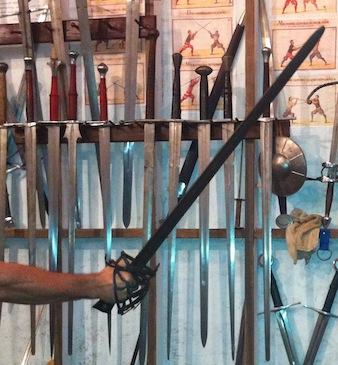 Therefore,
the only advice I can give my fellow arms enthusiast and connoisseur of
historical swords is to recommend those manufacturers who produce decent
quality machine-made replicas that are a good value for the money. Even
then, as their products and methods change from year to year, unless I
handle everything I cannot say for sure whether for any given model what
they make now is as good as what they made a few years ago or if it will
be as reliable a year from now. This isn't what people want to hear, I
know, but the matter is more complicated than generally imagined. Therefore,
the only advice I can give my fellow arms enthusiast and connoisseur of
historical swords is to recommend those manufacturers who produce decent
quality machine-made replicas that are a good value for the money. Even
then, as their products and methods change from year to year, unless I
handle everything I cannot say for sure whether for any given model what
they make now is as good as what they made a few years ago or if it will
be as reliable a year from now. This isn't what people want to hear, I
know, but the matter is more complicated than generally imagined.
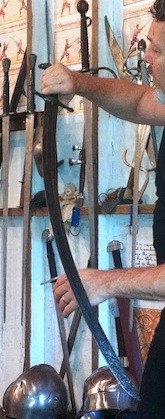 I've
been fortunate in that I've probably handled more historical swords than
nearly any other serious practitioner alive today and I've actually practiced
and even done cutting experiments with several authentic pieces. I also
do a tremendous amount of cutting experiments with modern replicas on
all sorts of accurate target materials. That, combined with my long study
of the genuine fencing methods, is what informs my views. That being said,
in the same regard as the historical fighting man, who knew nothing about
chemistry, temperature, trace elements, or reprocessing iron, but only
what worked in a fine blade, I myself cannot address the science of it.
I'm not a craftsman nor metallurgist nor smith; just a swordsman. I've
been fortunate in that I've probably handled more historical swords than
nearly any other serious practitioner alive today and I've actually practiced
and even done cutting experiments with several authentic pieces. I also
do a tremendous amount of cutting experiments with modern replicas on
all sorts of accurate target materials. That, combined with my long study
of the genuine fencing methods, is what informs my views. That being said,
in the same regard as the historical fighting man, who knew nothing about
chemistry, temperature, trace elements, or reprocessing iron, but only
what worked in a fine blade, I myself cannot address the science of it.
I'm not a craftsman nor metallurgist nor smith; just a swordsman.
Unfortunately, there is a good deal of nonsense argued back and forth
by different modern bladesmiths and companies trying to promote their
commercial products or hype some personal method. The useful information
that consumers and collectors need gets drowned out. What's worse, many
swordsmiths today end up producing beautiful "art pieces" rather
than functional tools with the correct center of gravity and cross-sectional
dimensions. How many of them know enough about the physical side to put
their blade through its proper paces, or bother getting feedback from
expert users who know how the real things are supposed to handle and move?
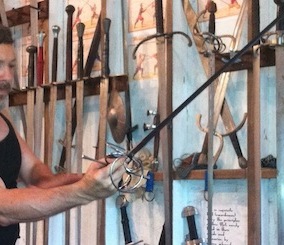 Problem
is, virtually no modern maker has their hand-forged pieces tested for
durability in warding off the full force blows of other sharp blades,
nor do they go around hitting soft and hard armors full force. They put
so much work and effort into their pieces that they're loathe to see them
damaged. And customers, having spent a lot of money, are not about to
damage them doing the same either. Over the years I've observed that most
every maker and every consumer does minimal work to evaluate a blade to
the point of destruction. They then base their future impressions of other
swords upon that small experience. Problem
is, virtually no modern maker has their hand-forged pieces tested for
durability in warding off the full force blows of other sharp blades,
nor do they go around hitting soft and hard armors full force. They put
so much work and effort into their pieces that they're loathe to see them
damaged. And customers, having spent a lot of money, are not about to
damage them doing the same either. Over the years I've observed that most
every maker and every consumer does minimal work to evaluate a blade to
the point of destruction. They then base their future impressions of other
swords upon that small experience.
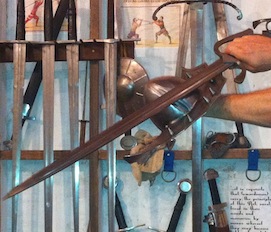 Every
sword though can be unique. Even ones that match the same general geometry
and form can vary considerably. I find I learn something new every time
I handle or closely examine an authentic specimen. When it comes to replicas,
unfortunately, there are just so many different elements to miss and crucial
factors to get wrong that the bad samples seem to outnumber the good ones
by around 100 to 1. Just getting the general shape and weight correct,
then using quality steel that's been properly tempered isn't enough. Every
sword though can be unique. Even ones that match the same general geometry
and form can vary considerably. I find I learn something new every time
I handle or closely examine an authentic specimen. When it comes to replicas,
unfortunately, there are just so many different elements to miss and crucial
factors to get wrong that the bad samples seem to outnumber the good ones
by around 100 to 1. Just getting the general shape and weight correct,
then using quality steel that's been properly tempered isn't enough.
One can pick up most any sword and make an instant decision as to whether
or not it "feels" good. But unless you "wield" it
in proper motion with the requisite energy it was designed to harness,
this is a very superficial appraisal. Much the same is true for any fine
instrument, whether it be a guitar, a tennis racket or a Ferrari. It's
evaluated best with respect to the actions for which it was supposed to
be put to use.
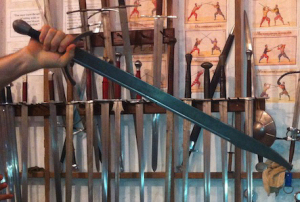 There
is a holistic combination of factors that go into making a sword really
stand out as a real weapon. This is evident not through holding a piece
in your hand or moving it through empty air. It's something that naturally
only comes out only when it's wielded with the requisite force and energy
necessary to strike effective blows against a test target combined with
practice in warding off forceful strikes. This is where you see whether
a weapon holds up and how well it maneuvers for whatever combat actions
it was originally conceived. Even then, how robust and agile the blade
feels inside its hilt is one matter, and how well its edge and point (or
even its flat) holds up to impact is another. There
is a holistic combination of factors that go into making a sword really
stand out as a real weapon. This is evident not through holding a piece
in your hand or moving it through empty air. It's something that naturally
only comes out only when it's wielded with the requisite force and energy
necessary to strike effective blows against a test target combined with
practice in warding off forceful strikes. This is where you see whether
a weapon holds up and how well it maneuvers for whatever combat actions
it was originally conceived. Even then, how robust and agile the blade
feels inside its hilt is one matter, and how well its edge and point (or
even its flat) holds up to impact is another.
I own a number of Medieval era replicas that seem soft, yet cut ferociously
even with a fairly unsharpened edge. I have had swords that are very hard
and well-honed, but whose edges shred when hitting on raw bone and meat
or when violently encountering other blades. Still others I've used were
ruined within minutes of clashing merely to bind and wind against one
another. But, I haven't seen much of this kind of distinct trauma on many
surviving historical specimens... which I think tells me a good deal about
how they were being employed.
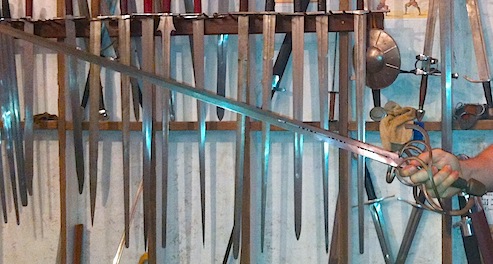
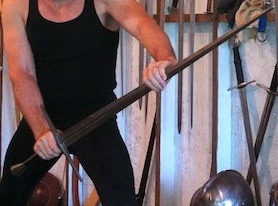 All
of this is complicated further when we consider not hand forged pieces,
but larger scale producers making machine-processed blades. It's not that
difficult to lathe out some superior modern steel into a historical shape
that is certainly capable of being used as a real weapon. However, these
still pale beside the originals in terms of weight, balance, and handling
characteristics, if not durability as well. Yet they can still appear
impressive if we're not careful in considering them. In my experience,
some modern manufacturers will often put extra sharp edges on their blades
to do seemingly impressive demonstrations of cutting power. They don't
perform the same tests with blunt swords for comparison; they'll never
let you inspect their blades afterwards to All
of this is complicated further when we consider not hand forged pieces,
but larger scale producers making machine-processed blades. It's not that
difficult to lathe out some superior modern steel into a historical shape
that is certainly capable of being used as a real weapon. However, these
still pale beside the originals in terms of weight, balance, and handling
characteristics, if not durability as well. Yet they can still appear
impressive if we're not careful in considering them. In my experience,
some modern manufacturers will often put extra sharp edges on their blades
to do seemingly impressive demonstrations of cutting power. They don't
perform the same tests with blunt swords for comparison; they'll never
let you inspect their blades afterwards to 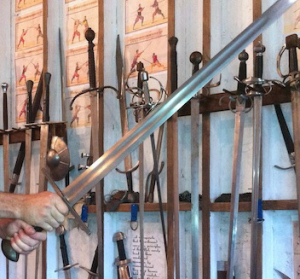 see
that they've warped from the impacts or that the edges were ruined in
the process. Nor do you see them ever warding off blows from other blades
to show that their swords are resilient enough to not be bent, broken,
or warped under the very kind of impacts they should have easily withstood.
(I won't name any companies. Sorry.) see
that they've warped from the impacts or that the edges were ruined in
the process. Nor do you see them ever warding off blows from other blades
to show that their swords are resilient enough to not be bent, broken,
or warped under the very kind of impacts they should have easily withstood.
(I won't name any companies. Sorry.)
Lastly, there is the problem of misinformed consumers who think that
in order to be a quality piece, a sword has to be repeatedly "slow-flexed"
by hand. They don't understand that violent flexibility under duress is
a sign of quality, not only of a good temper, but is itself a direct result
of a blade's cross-sectional shape and thickness. Depending on their intended
utility, many different kinds of swords were purposely designed not to
flex but rather to be as stiff as possible. Their strength lies in their
resilience--the virtually imperceptible way they maintain their shape
even as they impact violently against things you're trying to damage or
prevent from doing damage to you.
In the end, to anyone trying to discover the secrets of making historical
swords, all I can say is good luck. I want you to succeed. I need you
to succeed. So keep at it. Experiment. Study. Try. Just be aware that
a sword is not just a giant knife, that functionality should take precedent
over aesthetics, and that not all sword designs followed the same rules.

|

